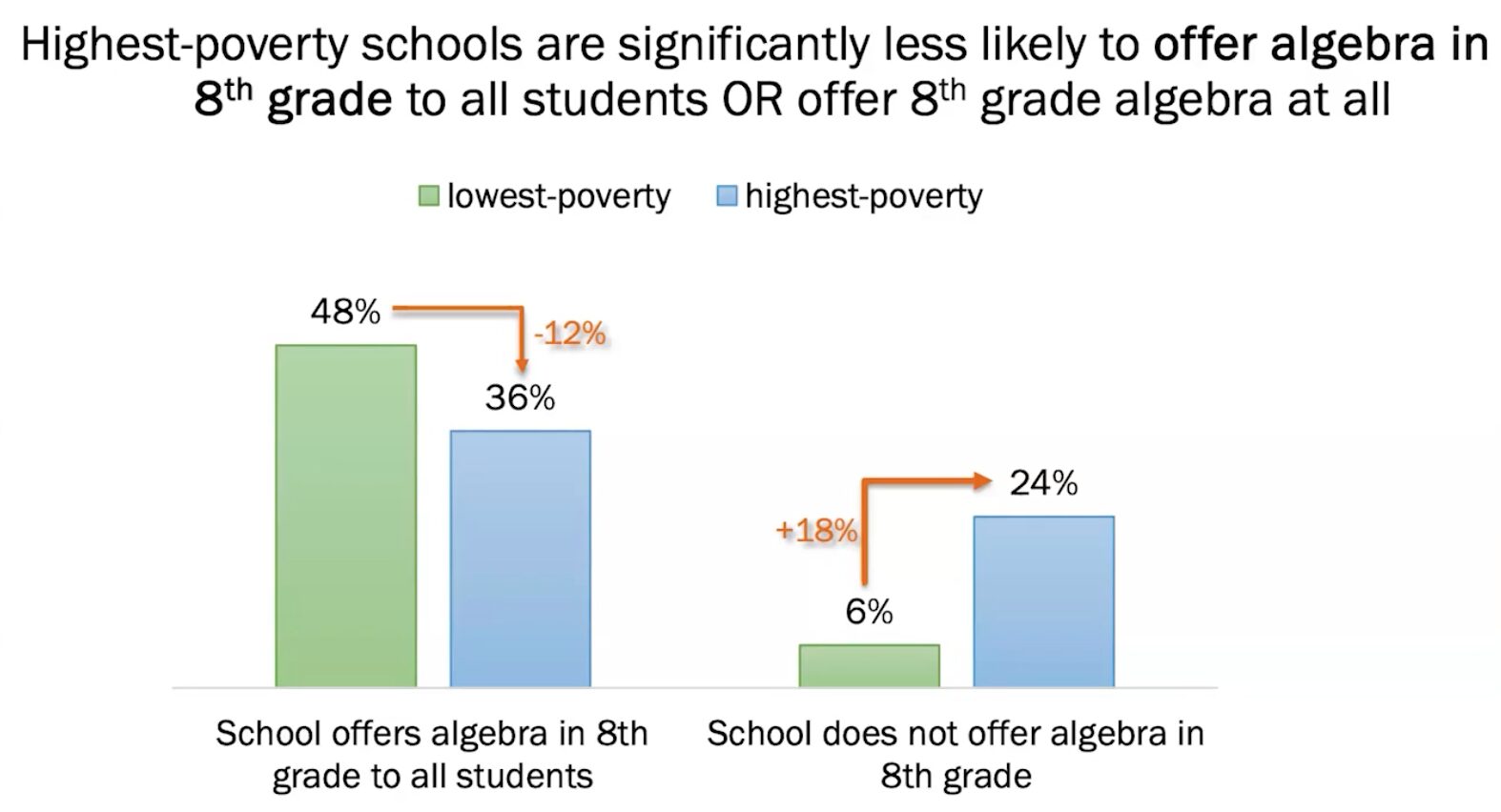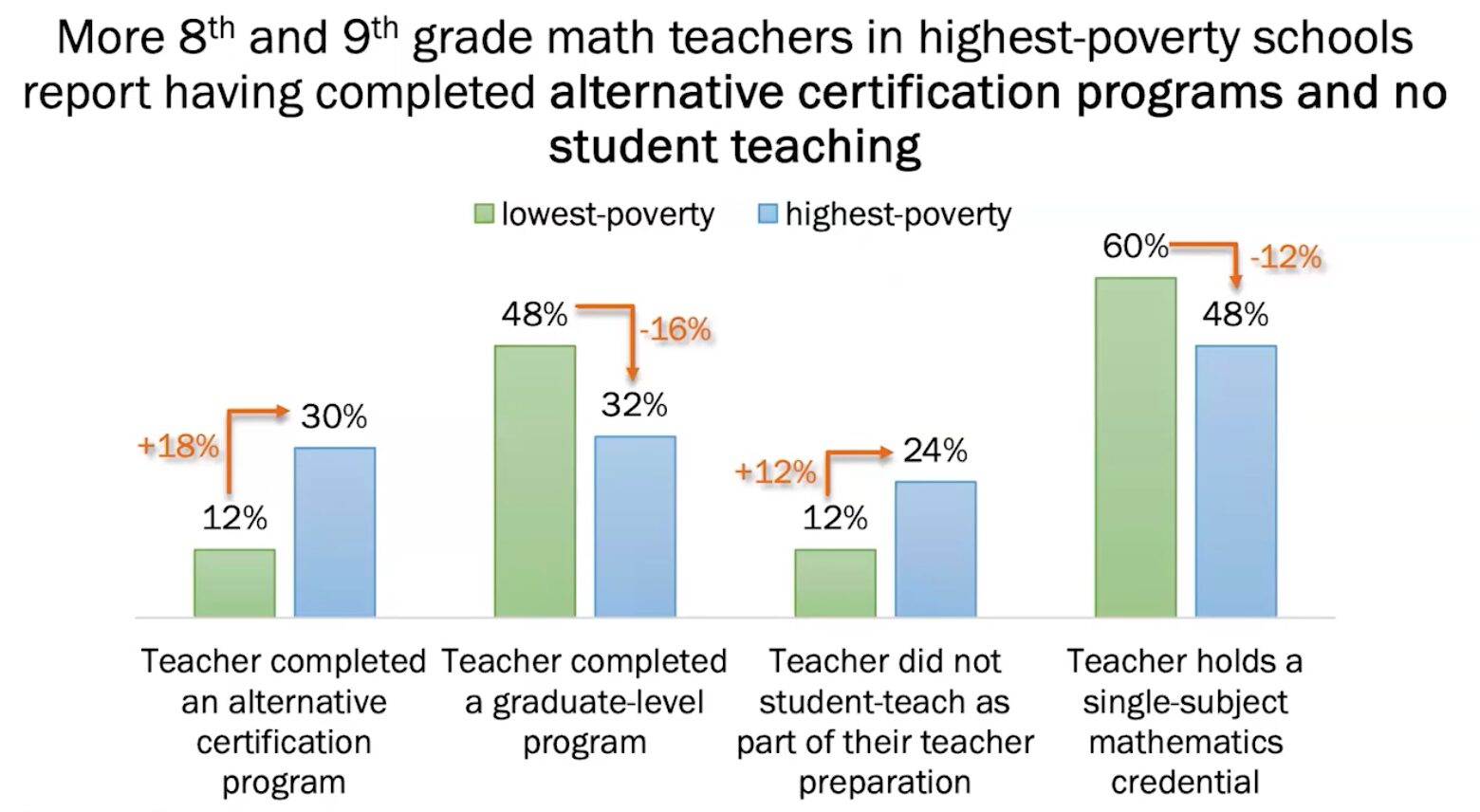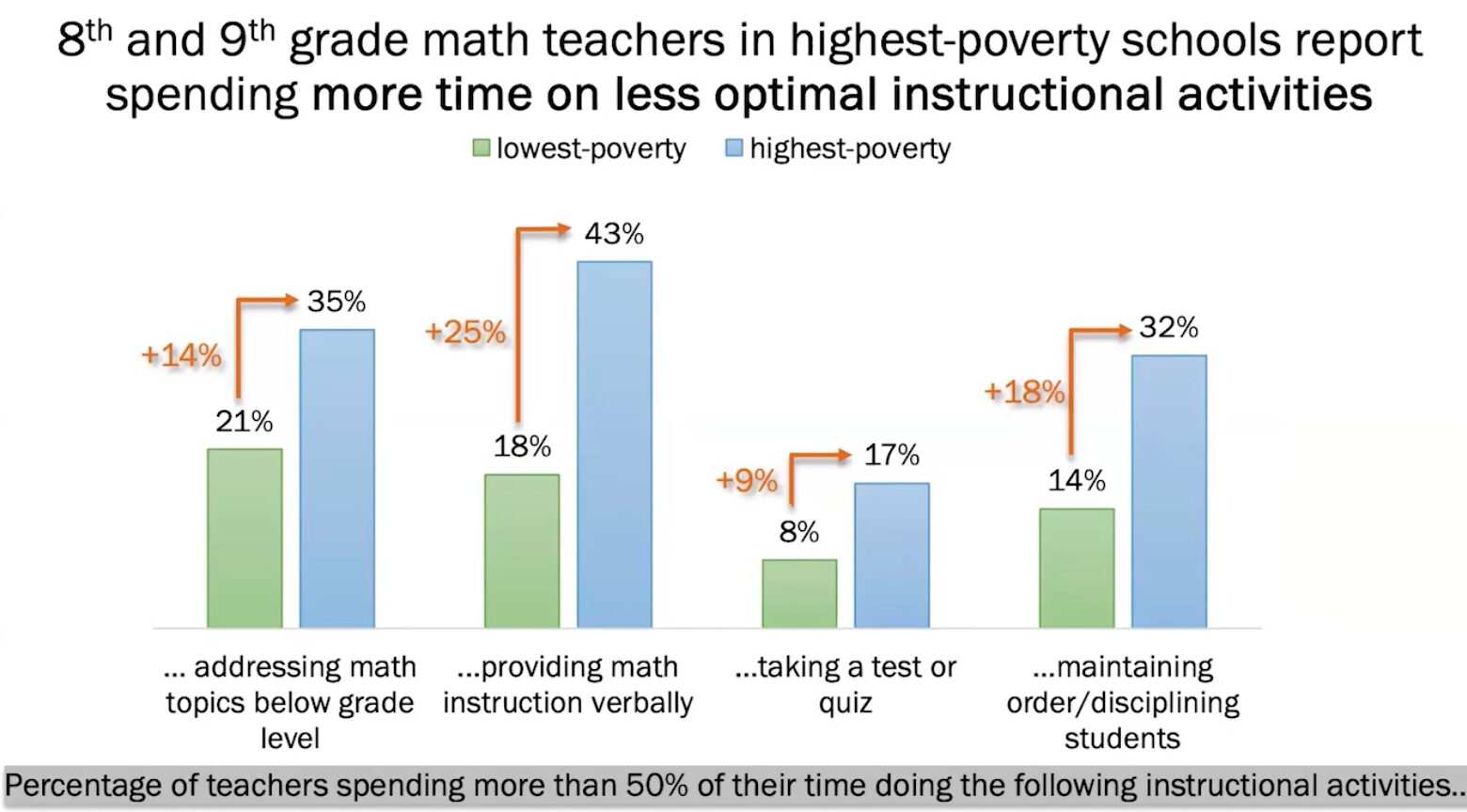 Surveys find access to algebra is only one problem in schools where teaching quality is ‘less optimal’
Surveys find access to algebra is only one problem in schools where teaching quality is ‘less optimal’
![]()
Like learning to read by third grade, taking eighth grade math is a pivotal moment in a child’s education. Students who pass Algebra 1 in eighth grade are more likely to sign up for more advanced math courses, and those who pass more advanced math courses are more likely to graduate from college and earn more money.
“Algebra in eighth grade is a gateway to a lot of further opportunities,” said Dan Goldhaber, an economist who studies education at the American Institutes for Research, in a recent webinar.
Researchers are trying to understand why so few Black and Hispanic students and low-income students of all races are making it through this early gate. While 25 percent of white students passed algebra in eighth grade in 2021, only 13 percent of Black students did, according to the most recent data from the U.S. Department of Education.
A collection of surveys of teachers and principals, conducted by the research organization RAND, suggests three problems at the poorest middle schools, which are disproportionately populated with Black and Hispanic students:
- Many schools don’t offer algebra at all.
- Their teachers have less training and math expertise.
- Their teachers spend classroom time differently than teachers do at wealthier schools.
That means the most advanced students at many middle schools in poor communities don’t have the opportunity to learn algebra, and many students at high-poverty schools aren’t receiving the kind of math lessons that could help them get ready for the subject.In 2023 and 2024,
RAND surveyed more than 3,000 school principals and almost 1,000 math teachers across the country.
The educators are part of a specially constructed national sample, designed to reflect all public schools and the demographics of the U.S. student population. A working paper, “Socioeconomic and Racial Discrepancies in Algebra Access, Teacher, and Learning Experiences,” analyzing some of the survey findings was released in October 2024.
[Related Grant Opportunity: Youth summer math program grants]
The poorest 25 percent of schools had vastly different course offerings and teachers than the wealthiest 25 percent. Most strikingly, nearly a quarter of the highest poverty schools didn’t offer algebra at all to any eighth graders, compared with only 6 percent of the wealthiest schools.
Conversely, poor schools are much less likely to adopt an algebra-for-all policy in eighth grade. Nearly half of the wealthiest schools offered algebra to all of their eighth grade students, regardless of math ability, compared with about a third of the poorest schools.

Slide from a RAND webinar, “Racial and Socioeconomic Divides in Algebra Teaching and Learning,” presented in November 2024.
[Related Grant Opportunity: GrantsMusic education, STEM and hearing impairment issues grants
Math teachers at high-poverty schools tended to have weaker professional preparation. They were far more likely to have entered the profession without first earning a traditional education degree at a college or university, instead completing an alternative certification program on the job, often without student teaching under supervision. And they were less likely to have a graduate degree or hold a mathematics credential.

Slide from a RAND webinar, “Racial and Socioeconomic Divides in Algebra Teaching and Learning,” presented in November 2024.
In surveys, a third of math teachers at high-poverty schools reported that they spent more than half of class time teaching topics that were below grade level, as well as managing student behavior and disciplining students. Lecture-style instruction, as opposed to classroom discussion, was far more common at the poorest schools compared to the wealthiest schools.
[Related: Why expanding access to algebra is a matter of civil rights]
RAND researchers also detected similar discrepancies in instructional patterns when they examined schools along racial and ethnic lines, with Black and Hispanic students receiving “less optimal” instruction than white students. But these discrepancies were stronger by income than by race, suggesting that poverty may be a bigger factor than bias.

Slide from a RAND webinar, “Racial and Socioeconomic Divides in Algebra Teaching and Learning,” presented in November 2024.
Many communities have tried putting more eighth graders into algebra classes, but that has sometimes left unprepared students worse off. “Simply giving them an eighth grade algebra course is not a magic bullet,” said AIR’s Goldhaber, who commented on the RAND analysis during a Nov. 5 webinar.
[Related: Thrown into the deep end of algebra]
Either the material is too challenging and the students fail or the course was “algebra” in name only and didn’t really cover the content. And without a college preparatory track of advanced math classes to take after algebra, the benefits of taking Algebra 1 in eighth grade are unlikely to accrue.
It’s also not economically practical for many low-income middle schools to offer an Algebra 1 course when only a handful of students are advanced enough to take it. A teacher would have to be hired even for a few students and those resources might be more effectively spent on something else that would benefit more students. That puts the most advanced students at low-income schools at a particular disadvantage. Go;dhaber said:
“It’s a difficult issue for schools to tackle on their own.”
Improving math teacher quality at the poorest schools is a critical first step. Some researchers have suggested paying strong math teachers more to work at high-poverty schools, but that would also require the renegotiation of union contracts in many cities. And, even with financial incentives, there is a shortage of math teachers.
[Related: Kindergarten math is often too basic. Here’s why that’s a problem]
For students, AIR’s Goldhaber argues the time to intervene in math is in elementary school to make sure more low-income students have strong basic math skills. “Do it before middle school,” said Goldhaber. “For many students, middle school is too late.”
***
Jill Barshay writes The Hechinger Report’s weekly “Proof Points” column about education research and data, covering a range of topics from early childhood to higher education. She also taught algebra to ninth-graders for the 2013-14 school year. Previously, Barshay was the New York bureau chief for Marketplace, a national business show on public radio stations. She has also written for Congressional Quarterly, The Wall Street Journal, The New York Times and the Financial Times, and appeared on CNN and ABC News.
This story about eighth grade math was produced by The Hechinger Report, a nonprofit, independent news organization focused on inequality and innovation in education. Sign up for Proof Points and other Hechinger newsletters.
This story also appeared in Mind/Shift.
Disclosure: The “Socioeconomic and Racial Discrepancies in Algebra Access, Teacher, and Learning Experiences” analysis was funded by the Bill & Melinda Gates Foundation, which is among the many funders of The Hechinger Report.


























